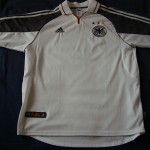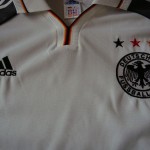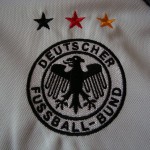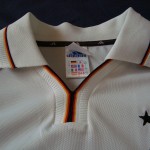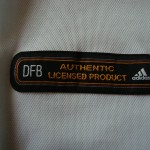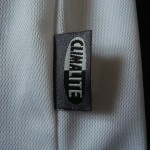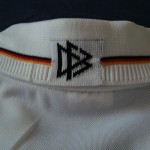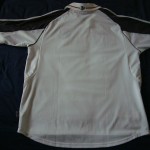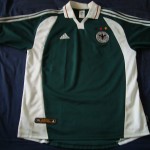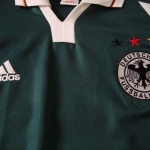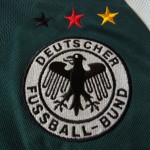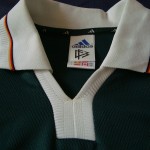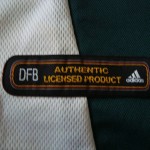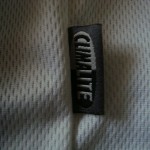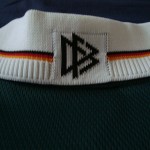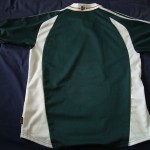Colours
Home: White shirt with black/grey trim, black shorts, white socks
Away: Green shirt with white trim, white or green shorts, green socks
Overview
Coaches: Erich Ribbeck, Rudi Völler.
2000 saw the launch of a new more classical looking Germany shirt – white with black/grey trim and a hint of Schwarz-Rot-Gold on the collar. Unfortunately, this classical-looking kit was worn by a not-at-all classical Germany side, at a time when German football was probably at the lowest point in its entire history. If the quarter-final exit at France 1998 at the hands of Croatia was bad enough, the two years under Erich Ribbeck is a period most fans of the Nationalmannschaft would choose to blot from their collective memory.
The design of the 2000-2002 shirt was nice and simple: a neat extended v-neck with small collar flaps piped in Schwarz-Rot-Gold, dark grey shoulders with the three Adidas sleeve stripes in white, and both the Adidas symbol and national eagle woven in fine black thread. Sitting tidily above the national eagle where the three stars in black, red and gold. Separating the grey/white shoulder design from the rest of the plain white shirt was some fine black piping that extended from the neck to the armpits. After the fashion disaster that was the previous effort, this was more like it; I actually enjoyed wearing this shirt, save for the occasions where I had to endure Ribbeck’s robots get steamrollered in Euro 2000.
On the back of the neck on the collar flap was a woven DFB logo in black thread, and at the lower left of the shirt was a simple black “authentic licensed product” label. A new feature Adidas had introduced was its special breathable “Climalite” material, which was indicated by the presence of a small monochrome tab stitched into the seam on the right-side of the shirt.
A Trikot with bad memories. Thomas Häßler challenges Portugal’s Nuno Capucho at Euro 2000
The home shirt was worn with black shorts, which had a dark grey side panel and the three trademark Adidas stripes in white. The national eagle was worn on the right side (left leg) and was woven into the fabric in white thread above the Adidas logo. Completing this Trikot were more traditional-looking white Strümpfe, topped with three thin horizontal stripes in Schwarz-Rot-Gold.
One of the few positive memories I have of this shirt took place in the autumn of 2000, with new coach Völler’s heavily reworked side grabbing a 1-0 win in what was the final game at the old Wembley stadium, the goal being a rather skiddy long-range strike by Didi Hamann.
The second kit was of a similar design in forest green with white trim, and was not much better in term of memories – it was worn during two defeats against England – the first in Charleroi at Euro 2000, and then that infamously horrific 1-5 home defeat – yes, the game in Munich where even Emile Heskey was able to find the back of the net.
The green shirt of 2000-2002 was of a similar design to the white one; the material was a forest green, a slightly darker shade than previous green DFB kits, and had a white v-neck with a small collar flap piped in Schwarz-Rot-Gold. There were two white side panels extending down from the shoulder, and unlike the home shirt there were white cuffs, which also had piping in the national colours. The national eagle was woven in black thread on a white circle, and was accompanied by the three championship stars in black, red and gold; the Adidas logo was stitched in white/silver thread.
The three other features on this green shirt were exactly the same as on the white one: the DFB logo stitched in black thread on the back of the white collar flap, the horizontal black “authentic licensed product” label at lower left and the small “Climalite” tab stitched into the side seam.
More bad memories. Sebastian Kehl tracks England’s David Beckham in München in 2001
The shorts usually worn with the 2000-2002 second shirt were usually white with a green side panel and the three Adidas-trademarked vertical stripes, but a green variation was also used, providing an all-green look. The green shorts had the same design as the white ones, but with the colours flipped around – a white side panel with the three stripes in green. On both versions the national eagle was stitched onto the left leg above the Adidas logo. The second Trikot was completed with green socks, which were of a standard design in having the simple three horizontal bands in white.
Wearing the green shorts, Carsten Jancker is challenged by England’s Sol Campbell at Euro 2000
I have always associated this shirt with the profligate Carsten Jancker – which says it all, really. It was Jancker who couldn’t hit a barn door from ten yards against England in Charleroi, and it was also Jancker who scored the opening goal in what soon turned into the 5-1 disaster against the same opposition in Munich. In fairness, he was also wearing this shirt when he scored a cracker in salvaging a 2-2 away draw against Finland.
Tournament Record
UEFA European Championship, Netherlands/Belgium: first round
Shirt Debuts
White: v Croatia, 29.03.2000, Zagreb.
Team: Kahn – Linke, Matthäus, Nowotny – Rehmer (46. Ramelow), D. Hamann, Ballack, Ziege (88. Beinlich) – Wosz – Kirsten (84. Rink), Bierhoff
Score 1-1 (Rehmer 12. / Niko Kovač 70.)
Green: v Netherlands, 23.02.2000, Amsterdam.
Team: Kahn – Babbel, Matthäus, Linke – Sebescen (46. Deisler), Jeremies, D. Hamann (61. Wosz), Ziege – Neuville (76. F. Baumann), – Bierhoff, Scholl
Score 1-2 (Ziege 22. / Kluivert 15., Zenden 28.)
Shirt Images
